Text this colour links to Pages. Text this colour links to Family Trees. Place the mouse over images to see a larger image. Click on paintings to see the painter's Biography Page. Mouse over links for a preview. Move the mouse off the painting or link to close the popup.
All About History Books
The Chronicle of Geoffrey le Baker of Swinbroke. Baker was a secular clerk from Swinbroke, now Swinbrook, an Oxfordshire village two miles east of Burford. His Chronicle describes the events of the period 1303-1356: Gaveston, Bannockburn, Boroughbridge, the murder of King Edward II, the Scottish Wars, Sluys, Crécy, the Black Death, Winchelsea and Poitiers. To quote Herbert Bruce 'it possesses a vigorous and characteristic style, and its value for particular events between 1303 and 1356 has been recognised by its editor and by subsequent writers'. The book provides remarkable detail about the events it describes. Baker's text has been augmented with hundreds of notes, including extracts from other contemporary chronicles, such as the Annales Londonienses, Annales Paulini, Murimuth, Lanercost, Avesbury, Guisborough and Froissart to enrich the reader's understanding. The translation takes as its source the 'Chronicon Galfridi le Baker de Swynebroke' published in 1889, edited by Edward Maunde Thompson. Available at Amazon in eBook and Paperback.
Castle Esplanade, Edinburgh is in Castlehill, Edinburgh.
Colonel MacKenzie Monument, Castle Esplanade, Castlehill, Edinburgh, Scotland, British Isles [Map]
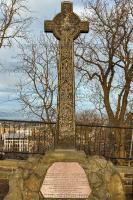
1875Colonel MacKenzie Monument [Map]. Monument to Colonel Kenneth Douglas Mackenzie (age 63). The inscription reads:
'In memory of Colonel Kenneth Douglas Mackenzie, C.B. who served for forty two years in the 92nd highlanders and on the staff of the army in all parts of the world. He saw much service in the field and deserved well of his country, both in war and in peace. Active, frank, and loyal, he won the confidence of his superiors, the respect of those under him and the love of all who knew him. Born at Dundee 1st February 1811. Died on duty at Dartmoor 24th august 1873. His motto through life being 'godliness with contentment is great gain!' This memorial is erected in affectionate remembrance by many of his friends'.
The sculptor was Sir John Steell (1804–91).
Colonel Kenneth Douglas Mackenzie: On 1st February 1811 he was born to Donald Mackenzie and Daughter of T Mylne. On Sunday, 24th August 1873, Colonel Kenneth Douglas Mackenzie and his brother-in-law, Captain Colomb, attempted to ford the little river Meavy, which was flooded with the recent rains, when the horse was swept off his legs, the gig upset, and the occupants with difficulty reached the bank. Mackenzie died immediately afterwards of syncope induced by exhaustion. He left a widow, daughter of Lieutenant-general G. T. Colomb, whom he married in 1861.
Ensign Ewart Monument, Castle Esplanade, Castlehill, Edinburgh, Scotland, British Isles [Map]
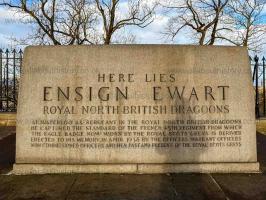
In 1938 the grave of Charles Ewart was uncovered, and his body was reburied by the Royal Scots Greys (as they were then titled) on the esplanade of Edinburgh Castle; the Ensign Ewart Monument [Map].
Gordon Highlanders South African War Memorial, Castle Esplanade, Castlehill, Edinburgh, Scotland, British Isles [Map]
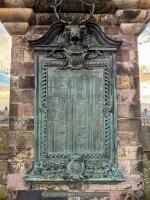
29th December 1903Gordon Highlanders South African War Memorial [Map]. Unveiled by Earl of Kintore, the Colonel commanding the 3rd Battalion Gordon Highlanders.
India Cross, Edinburgh, Castle Esplanade, Castlehill, Scotland, British Isles [Map]
India Cross, Edinburgh [Map]. Erected in 1862 by public subscription, it reads: "This sandstone cross commemorates the men of the 78th Highlanders who died during the Indian Rebellion or Mutiny of 1857-8". And under the heading "Heroes of Lucknow" continues: "Indian soldiers rose against British rule and besieged Lucknow in June 1867. In September soldiers of the 78th fought through rebel ranks to relieve the city. Eight members of the regiment were awarded the Victoria Cross.
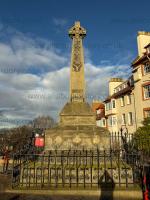
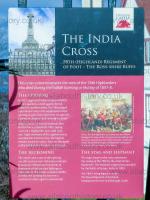
Prince Frederick Monument, Castle Esplanade, Castlehill, Edinburgh, Scotland, British Isles [Map]
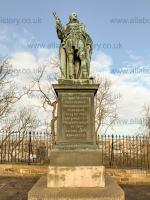
Monument to Prince Frederick Hanover Duke of York. Sculpted by Thomas Campbell and unveiled in 1836.
The inscription on the front (south) face reads "Field Marshal his Royal Highness Frederick Duke of York and Albany, K.G. Commander in Chief of the British Army, MDCCCXXVII". On the rear (north) an inscription simply states "Erected MDCCCXXXVI".
Scottish Horse Monument, Edinburgh, Castle Esplanade, Castlehill, Scotland, British Isles [Map]
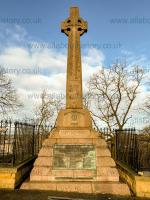
Scottish Horse Monument, Edinburgh [Map]. In November 1900, Lord Kitchener sanctioned the raising of a regiment known as the Scottish Horse to help annexe the South African Republic and Orange Free State to the British Empire. Men were recruited from Scotland, Australia and South Africa and conducted a guerrilla campaign, launching night raids on their Boer counterparts. This memorial commemorates the men who fell during this campaign.
The memorial was designed by the firm of Stewart McGlashan and Son, an Edinburgh based firm of monumental sculptors. The firm produced a large number of monuments for Glasgow and Edinburgh cemeteries and was also responsible for a number of public monuments including the William Wallace Monument, (Robroyston, Glasgow) and the Robert the Bruce and Boer War memorial in Dunfermline Abbey.